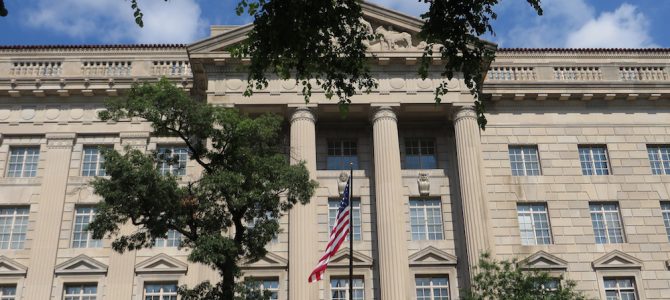
Donald Trump rose to electoral success in 2016 on a tidal wave of support from the Midwest, a region other Republican presidential candidates have struggled in vain to win since the 1980s. His wins in Ohio, Wisconsin, and Michigan did not represent a victory for standard Republican ideas of free trade, low taxes, and smaller government. Instead, they represented faith in his promise to return prosperity to the former industrial heartland, and a lack of trust in Hillary Clinton to do the same. What remains to be seen now is whether Trump can deliver on his promises, or if he will join a long list of establishment politicians who have sworn to revitalize that region and failed.
There is reason to doubt that raising tariffs, Trump’s go-to policy on trade, will return the Midwest to its industrial employment heyday. As Scott Lincicome wrote earlier this year, it is “highly unlikely the Trump tariff would lead to a significant increase in U.S. manufacturing.” Bill Watson of the Cato Institute concurs:
For one thing, trade isn’t actually the main driver behind the decrease in manufacturing employment, which began in 1979, long before China became a major U.S. trading partner. Part of the decline is due to trade but the vast majority is due to technological improvements that have enabled greater efficiency and automation. That’s why even as manufacturing employment has decreased, manufacturing output has continued to rise and is now at an all-time high.
Trump Can Help Americans By Moving Jobs Out Of D.C.
But even if tariffs on China and other developing world countries do stimulate manufacturing job growth in the United States, the effects will not be immediate. If Trump wants to increase employment in the states he took from the Democratic column in 2016, there are other ways to do so. Most times, when a President says he created jobs, what he means is that jobs were created while he occupied the White House. Maybe he worked with Congress to make conditions more favorable for job creation, but more often he is just the beneficiary of worldwide economic trends.
The exception to this is in the creation of jobs through actually hiring people to work for the federal government. Here a President can actually affect the number and, more importantly, the location of the jobs the federal government provides. The best way for Trump to enact a better federal employment program that is fiscally conservative enough to satisfy a Republican Congress, therefore, is not to create more federal jobs but to move existing ones away from the Washington area and out into the rest of the country, especially in those areas that have been hurt most by long-term unemployment.
I first wrote about this idea a year ago, when Jeb Bush or Ted Cruz looked more likely to win the Presidency than Donald Trump. The idea of spreading federal jobs across the country fits even better with Trump’s “Drain the Swamp” theme than with any of the other candidates. Trump is not a creature of Washington. The biggest theme in his election was a conflict between the ins and the outs, or as Peggy Noonan called them, the “protected” and the “unprotected.” Many of the residents of Washington and its suburbs feel protected by their secure and steady federal employment and have a sense of safety that is unknown among the residents of cities and towns that have seen factories and mines close down one after the other for decades. Trump could give them a greater sense of security by giving them access to those same federal jobs.
Washington Disproportionately Pleases Washingtonians
As I wrote before, according to Census Bureau’s American Community Survey, in 2012 “the Washington metro area had an average household income of $88,233—the highest in the country, and far in excess of the national average of $51,371. The list of the United States’ highest-income counties confirms the point, with 13 of the richest 30 counties (and four of the top five) being within the Washington metro area.”
This situation is exactly the sort of disparity that led many in the post-industrial Midwest to see the federal government as the protector of only those lucky enough to have government jobs or live in big cities. And while cities will always be centers of innovation and prosperity, there is no reason why so much of that prosperity must be concentrated in one city.
To the extent the government controls a source of employment, those jobs should be distributed among the people as evenly as possible. There are other reasons, as well, that Trump might favor spreading the jobs around the country. Again, as I wrote in 2015:
Moving government offices (and even entire executive departments) out of the beltway and its periphery would have three effects. Firstly, it would give the rest of the country access to those high-quality government jobs that the Washington establishment has kept for its own. Secondly, and no less importantly, it would throw a wrench into the revolving door of bureaucracy to lobbying shop to government contractor and back again that characterizes life in the federal metropolis.
Thirdly, it would open those jobs to people with experience who live and work in the communities the agencies purport to serve. Shifting those jobs to the 48 states outside the DC area would pour federal tax money back into the communities from which it came, and at the same time would give new people—people not inured to the bureaucratic-contractor complex—a chance to compete for those jobs and to bring new, non-government experiences and knowledge to the federal workplace.
Decentralizing Could Help Hurting Towns
Some of the biggest voting swings to Trump in 2016 were in places like Youngstown, Ohio. Youngstown is part of Mahoning County, which voted for Obama in 2008 and 2012 by 26 and 28 percentage point margins, respectively. Trump cut that margin down to three points while winning the surrounding counties of Stark, Portage, and Trumbull, all of which voted for Obama in 2012. This is an area that is crying out for change.
Trump could get things started in a new direction by relocating some federal jobs there from Washington. Even if not a single factory reopens in the next four years, such a move would add material prosperity to a region in desperate need of it. According to the Bureau of Labor Statistics, Youngstown’s metropolitan area ranked 317th in the nation for employment. Some federal jobs could help with that.
There were once good reasons for concentrating federal jobs near the capital. In the explosion of federal employment that accompanied the New Deal in the 1930s, it made sense for people working together to be physically near each other. The files and folders of that time were made of paper and manila, and if you wanted to look at them, you had to do so physically.
In the twenty-first century, however, the words “file” and “folder” are used more often to describe digital information than physical objects. They can be created, edited, and reviewed anywhere a worker has access to the internet. The federal government is already a leader in remote workplaces. For a D.C.-based worker, that tends to mean working remotely from Arlington, not Akron, but there is no need for such a geographic restriction.
Moving Government Jobs Could Save Taxpayer Money
The move would also save the federal government money in the long term. Federal workers in expensive areas—like Washington—are paid more, to make up for the higher cost of living there. A worker in D.C. makes over 10 percent more than one doing the same job in Youngstown. Move enough workers out of expensive areas, and the savings to the taxpayers start to add up. Government workers and their families would benefit, too: 90 percent of a D.C. salary goes much farther in Youngstown than 100 percent of it goes in Washington.
Trump made a lot of promises over the course of the campaign, some of which will prove impossible to fulfill. Relocating government jobs is one thing he can do to “drain the swamp” and promote economic prosperity outside the Beltway. He and the Republican Congress should consider it as one way to prove their commitment to changing the way Washington does business and using the government to help regions besides the nation’s capital.








